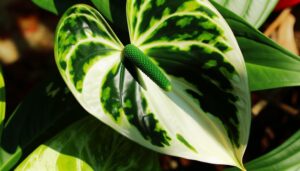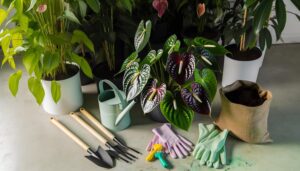Comprehensive Guide to Anthurium Vittarifolium Care
For best care of Anthurium vittarifolium, provide bright, indirect light and avoid direct sunlight. Use well-draining soil with a mix of orchid bark, perlite, and peat moss.
Maintain humidity levels around 70-80%, using misting, pebble trays, or a humidifier. Water thoroughly, letting the soil dry between waterings.
Fertilize with a balanced, water-soluble fertilizer every 4-6 weeks during the growing season and reduce in winter. Regularly prune dead leaves and clean foliage.
Prevent pests and diseases by monitoring and using insecticidal soap or neem oil. Propagate through stem cuttings or division techniques.
Discover additional in-depth tips ahead.
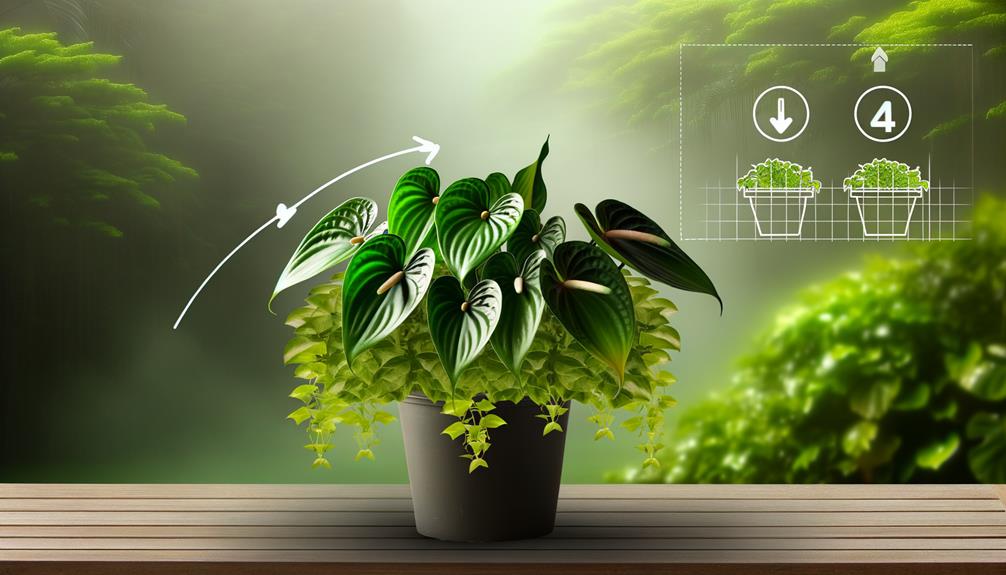
Key Takeaways
- Place Anthurium Vittarifolium in bright, indirect light, avoiding direct sunlight.
- Maintain high humidity (70-80%) using misting, humidifiers, or pebble trays.
- Use a well-draining soil mix with 40% orchid bark, 30% perlite, and 30% potting soil.
- Fertilize every 4-6 weeks during the growing season with a balanced water-soluble fertilizer.
- Regularly inspect for pests and diseases, treating infestations early with insecticidal soap or neem oil.
Ideal Lighting Conditions
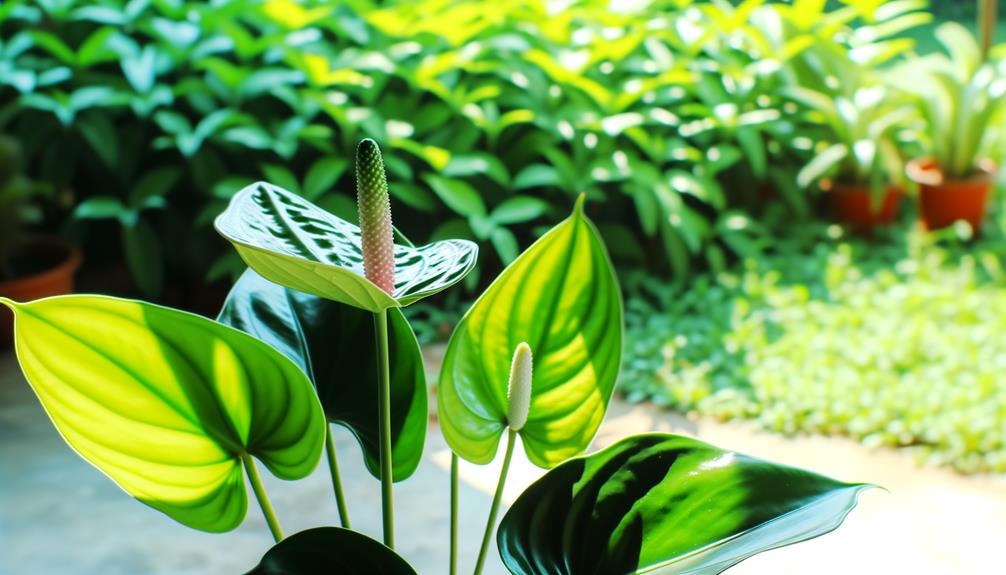
Anthurium vittarifolium thrives best in bright, indirect light, mimicking the dappled sunlight it receives in its native tropical rainforest habitat. Direct sunlight can scorch its delicate leaves, while insufficient light may hinder growth and flowering.
Position the plant near an east or north-facing window, where it can receive diffused light. Alternatively, a spot with filtered sunlight through sheer curtains will suffice. For areas with low natural light, consider using fluorescent grow lights to simulate the optimal conditions.
Guarantee the plant receives 12-14 hours of light daily to maintain its vibrant foliage and overall health. Regularly rotate the plant to guarantee even light exposure, preventing uneven growth and promoting a balanced, aesthetically pleasing appearance.
Proper Watering Techniques
How does one secure optimal hydration for Anthurium vittarifolium while preventing root rot and other water-related issues?
The key lies in understanding the plant’s natural rainforest habitat, which provides high humidity and well-drained conditions.
Water the plant thoroughly, making certain water drains completely from the pot to avoid stagnation. Allow the top inch of soil to dry out between waterings.
Use room-temperature, distilled or rainwater to prevent mineral build-up.
Monitor the plant closely; yellowing leaves often indicate overwatering, while crispy edges suggest underwatering.
Additionally, mist the leaves regularly to maintain humidity levels.
Best Soil Mix

To promote ideal growth for Anthurium Vittarifolium, selecting the right soil mix is crucial.
A well-draining, aerated substrate composed of orchid bark, perlite, and peat moss in equal parts provides the perfect environment.
This combination promotes superb drainage while retaining sufficient moisture and nutrients, allowing the roots to breathe and reducing the chance of root rot.
Ideal Soil Composition
A well-draining soil mix composed of orchid bark, perlite, and high-quality potting soil is essential for the best growth of Anthurium vittarifolium. Orchid bark provides the necessary structure and drainage, preventing root rot by allowing excess water to pass through efficiently.
Perlite, a volcanic glass, enhances aeration and further improves drainage, ensuring that oxygen reaches the roots. High-quality potting soil contributes essential nutrients and retains adequate moisture without becoming waterlogged.
For optimal results, aim for a mix ratio of 40% orchid bark, 30% perlite, and 30% potting soil. This balanced composition mimics the plant’s natural epiphytic environment, facilitating healthy root development and robust foliage growth.
Regularly check the soil to maintain its best consistency.
Drainage and Aeration
Promoting proper drainage and aeration is crucial for the thriving growth of Anthurium vittarifolium, as these factors prevent root rot and support ideal root health.
A highly recommended soil mix includes a combination of orchid bark, perlite, and peat moss. This mix guarantees adequate drainage and retains sufficient moisture without waterlogging the roots.
Orchid bark provides structural aeration, while perlite enhances drainage and prevents soil compaction. Peat moss retains moisture and supports nutrient availability. A ratio of 40% orchid bark, 30% perlite, and 30% peat moss is optimal.
Additionally, incorporating activated charcoal can further enhance aeration and prevent fungal growth. Regularly monitoring soil moisture and adjusting the mix as needed ensures the plant’s long-term well-being.
Humidity Requirements
Anthurium Vittarifolium thrives in environments with high humidity, ideally between 70-80%. To achieve these levels, consider employing methods such as using a humidifier, pebble trays, or regular misting.
It is also vital to consistently monitor humidity with a hygrometer to maintain ideal growing conditions.
Optimal Humidity Levels
Maintaining ideal humidity levels, ideally between 70-80%, is essential for the healthy growth and vibrant foliage of Anthurium Vittarifolium.
High humidity mimics the plant’s natural tropical habitat, ensuring the best physiological function and preventing issues such as leaf browning or curling.
Consistently monitoring ambient moisture levels using a hygrometer can aid in maintaining these conditions effectively.
Placing the plant in a naturally humid environment, such as a bathroom or kitchen, can also be beneficial.
Excessive dryness, particularly below 50%, can hinder nutrient uptake and stunt growth.
Achieving and sustaining appropriate humidity levels is critical for promoting robust health and elongated, lush leaves in Anthurium Vittarifolium.
Humidity Boosting Methods
Implementing effective humidity-boosting methods is crucial for replicating the tropical environment necessary for Anthurium Vittarifolium‘s peak growth.
A dependable method involves placing a humidity tray filled with water and pebbles beneath the plant. This technique increases ambient moisture through evaporation.
Additionally, utilizing a room humidifier maintains consistent humidity levels, particularly during dry seasons. Grouping plants together can also create a microenvironment that enhances humidity naturally.
Mist the foliage regularly using distilled water to avoid mineral deposits. Finally, position the plant in a bathroom or kitchen, areas typically higher in humidity.
These practical, scientifically-backed strategies guarantee the Anthurium Vittarifolium receives the moisture it needs for best health and growth.
Monitoring Humidity Levels
Accurately tracking humidity levels is crucial to secure the best environment for Anthurium Vittarifolium, as this tropical plant thrives in humidity levels between 60% and 80%.
Utilizing a hygrometer, a device designed to measure humidity, can provide precise readings. Positioning the hygrometer close to the plant guarantees accurate data.
Additionally, incorporating a humidifier can help maintain ideal conditions, especially during dry periods.
- Hygrometer Placement: Place nearby the plant for precise readings.
- Humidifier Use: Useful during dry spells to maintain peak humidity.
- Regular Monitoring: Check readings daily to adjust as necessary.
- Misting: Light misting can temporarily elevate humidity levels.
- Avoid Drafts: Secure the plant is not exposed to air currents, which can reduce humidity.
These steps will secure a thriving Anthurium Vittarifolium.
Fertilizing Schedule
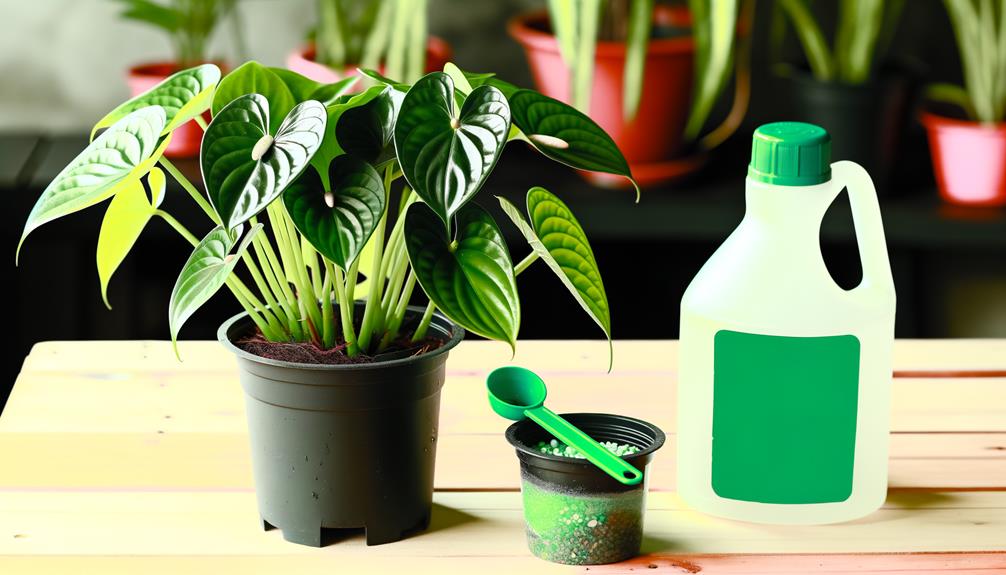
To maximize growth and vibrant foliage in your Anthurium Vittarifolium, it is essential to follow a consistent and balanced fertilizing schedule tailored to its specific nutrient needs.
Use a high-quality, water-soluble fertilizer with a balanced N-P-K ratio, such as 20-20-20, diluted to half strength. Apply the fertilizer every four to six weeks during the growing season, which typically spans from spring to early autumn. Verify the soil is moist before application to prevent root burn.
During the winter months, reduce fertilization to once every two to three months, as plant growth naturally slows. Incorporating a slow-release fertilizer can also be beneficial to maintain steady nutrient availability. Regular monitoring of soil pH can enhance nutrient uptake efficiency.
Pruning and Maintenance
Pruning and maintenance of Anthurium Vittarifolium involve removing dead or yellowing leaves, trimming any leggy growth, and regularly cleaning the foliage to promote best plant health and aesthetics. Regular maintenance tasks are essential for sustaining the plant’s vitality and appearance.
Remove dead leaves: Regularly inspect and prune dead or discolored leaves to prevent disease spread.
Trim leggy growth: Cut back elongated stems to encourage bushier growth and maintain structural integrity.
Clean foliage: Gently wipe leaves with a damp cloth to remove dust, enhancing photosynthesis.
Inspect for damage: Regularly check for signs of mechanical damage or stress, taking corrective actions as needed.
Sanitize tools: Always use sterilized pruning shears to avoid pathogen transmission.
These practices ensure a thriving, aesthetically pleasing Anthurium Vittarifolium.
Common Pests and Diseases
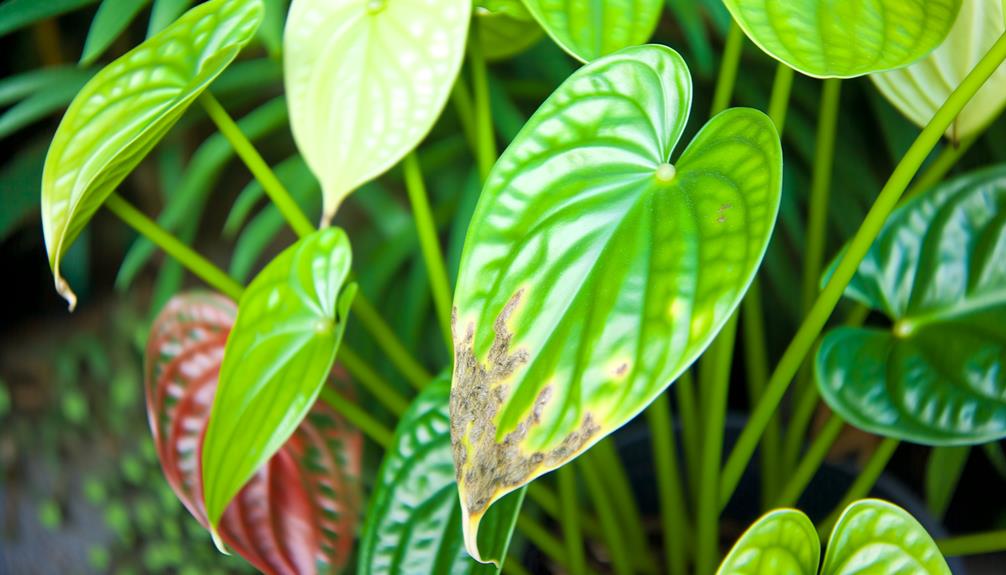
Common pests and diseases that affect Anthurium Vittarifolium frequently include aphids, spider mites, mealybugs, root rot, and bacterial blight.
Aphids, spider mites, and mealybugs can be controlled using insecticidal soap or neem oil, applied every 7-10 days until eradicated. Ensure proper airing and avoid over-watering to prevent root rot, characterized by wilting and yellowing leaves.
Bacterial blight manifests as water-soaked lesions and can be managed by removing affected leaves and ensuring good air circulation. Sterilize pruning tools between uses to prevent disease spread.
Regularly inspect plants for early signs of infestation or disease, as immediate intervention is essential for maintaining plant health. Employing these practices will help keep your Anthurium Vittarifolium thriving.
Propagation Methods
Propagation of Anthurium Vittarifolium can be effectively achieved through stem cuttings or division, each method offering distinct advantages for the home gardener.
Stem cuttings involve selecting a healthy section of the plant and placing it in a moist, well-draining medium to encourage root development.
Division requires separating a mature plant into smaller sections, each with its own root system. Both methods benefit from stable humidity and indirect light.
- Ensure sterile tools: Use disinfected shears to avoid transferring pathogens.
- Optimal medium: Employ a mix of sphagnum moss and perlite for best results.
- Humidity control: Maintain high humidity, ideally around 60-70%.
- Rooting hormone: Apply to cuttings to enhance root growth.
- Post-propagation care: Gradually acclimate new plants to lower humidity.
Conclusion
To sum up, maintaining ideal conditions for Anthurium vittarifolium requires focus on:
- lighting,
- watering,
- soil composition,
- humidity,
- fertilization,
- pruning,
- pest control, and
- propagation.
Following these guidelines will promote strong growth and colorful foliage.
What better way to appreciate the beauty of this exotic plant than by meticulously tending to its requirements?
By applying these scientifically-supported, hands-on suggestions, one can nurture a robust and flourishing Anthurium vittarifolium.

